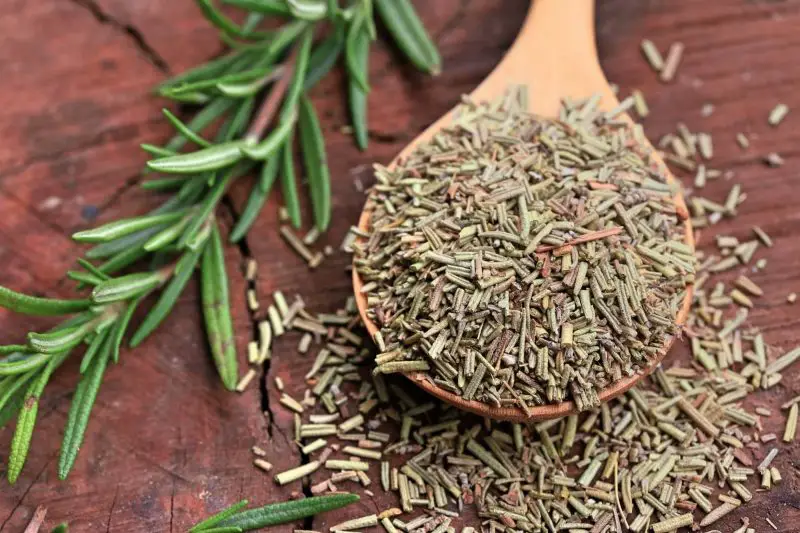Rosemary has long been celebrated as a herb of both flavor and tradition. Its pine-like aroma and earthy taste bring warmth to countless recipes, from roasted vegetables to savory breads. Beyond the kitchen, rosemary carries a history of healing and memory, often treasured in herbal remedies. Yet, its freshness fades quickly once picked, leaving many cooks wishing they could preserve its essence longer.
Drying rosemary offers the perfect solution. When done properly, it locks in the herb’s fragrance, taste, and beneficial oils for months. A handful of dried rosemary can transform simple dishes, enrich teas, or enhance homemade remedies. Mastering the right techniques ensures you enjoy this herb year-round, turning each harvest into a lasting supply. Learning how to dry rosemary the right way is not just practical but also deeply rewarding.
Why Drying Rosemary Matters

Drying rosemary is more than a method of preservation; it is a way of capturing the herb’s soul. Fresh rosemary brings an immediate burst of fragrance and flavor, but its leaves lose vitality quickly after harvest. By drying, you extend the life of every sprig, keeping the oils and aroma locked inside. This means you can enjoy the same earthy, slightly piney taste months after the plant has been cut. For anyone who cooks regularly, having a steady supply of dried rosemary ensures no recipe ever lacks depth or fragrance.
The importance of drying rosemary also lies in its versatility. Dried rosemary is not limited to cooking alone. It can be infused into oils for marinades, added to herbal teas, or even used in natural remedies. Some people keep dried rosemary in sachets to freshen drawers or hang it as decoration. Each use highlights how valuable this herb becomes once properly preserved. Unlike many delicate herbs, rosemary’s sturdy leaves maintain character when dried, making it especially reliable.
Another reason drying rosemary matters is sustainability. A thriving rosemary plant may produce more than you can use fresh. Instead of wasting those extra branches, drying gives you a way to save them. This reduces food waste and rewards the effort you put into growing or purchasing the herb. More importantly, it connects you to traditional practices where nothing was wasted. Drying rosemary offers not just convenience but also a sense of care and respect for the plant. It transforms a fleeting harvest into a resource you can rely on throughout the year.
Preparing Rosemary Before Drying
Optimal Time of Day for Harvest
Harvesting rosemary at the right time of day plays a crucial role in capturing the herb’s strongest flavor and aroma. The best moment is early in the morning after the dew has evaporated but before the sun becomes too intense. During this window, the plant’s essential oils are at their highest concentration, which enhances both taste and fragrance. Cutting sprigs later in the day, especially under harsh sunlight, can cause the oils to dissipate, leaving the leaves less aromatic. By respecting this timing, you not only preserve the herb’s natural qualities but also reduce stress on the plant.
It is also important to consider weather conditions when planning your harvest. Avoid collecting rosemary immediately after rainfall, since moisture can dilute flavor and encourage mold during drying. Similarly, harvesting during periods of extreme heat or drought can leave the plant weak and lower oil production. By aligning your harvest with both daily and seasonal rhythms, you ensure the sprigs you cut are at their peak quality. This careful approach results in dried rosemary that carries rich aroma and bold taste, perfect for both cooking and herbal remedies.
Frequency of Harvest
Harvesting rosemary at the right frequency is just as important as choosing the right time of day. Cutting too often or taking too much can weaken the plant and slow its recovery. A good rule is never to remove more than one-third of the plant at one time. This ensures the remaining foliage continues photosynthesis, keeping the plant strong and productive. Regular, moderate harvesting actually encourages bushier growth, preventing the rosemary from becoming woody or sparse. Younger, tender stems are best for frequent harvesting since they regrow quickly and contain higher levels of aromatic oils.
The ideal frequency also depends on the season. In spring and summer, rosemary grows more vigorously, so you can harvest more often without harming the plant. During autumn and winter, growth slows, so harvest sparingly to avoid stress. Observing the plant’s condition helps you judge when it is ready for another trim. By maintaining balance, you protect the plant’s vitality while ensuring a constant supply of flavorful leaves. This thoughtful approach provides both immediate use in cooking and long-term sustainability for your rosemary garden.
Cleaning and Handling Rosemary Sprigs
Proper cleaning and handling of rosemary sprigs is an essential step before the drying process. After harvesting, gently rinse the sprigs under cool running water to remove dirt, dust, or insects. Avoid using harsh scrubbing, as this can bruise the leaves and cause loss of essential oils. Once rinsed, pat the sprigs dry carefully with a clean kitchen towel or paper towel. Allowing excess moisture to remain increases the risk of mold during drying. For best results, spread the sprigs out on a drying rack for a short time to ensure every part is dry before you proceed.
Handling rosemary with care also preserves its quality and aroma. Strip away any damaged or yellowing leaves, keeping only the healthiest sprigs for drying. If you plan to hang rosemary bundles, remove the lower leaves from the stems to improve airflow. When preparing for oven or dehydrator drying, cut the sprigs into uniform sizes for even results. These small but important steps prevent uneven drying and loss of flavor. By paying attention to cleaning and handling, you protect the herb’s natural oils, ensuring that your dried rosemary remains fragrant, flavorful, and ready to use for months.
Different Methods for Drying Rosemary
Air Drying Rosemary
Air drying is the oldest and simplest method to preserve rosemary. This technique requires no equipment and maintains much of the herb’s natural oils. Start by gathering healthy sprigs and tying them into small bundles. Avoid making the bundles too thick, as good air circulation is essential for proper drying. Hang the bunches upside down in a cool, dry place away from direct sunlight. Sunlight may reduce the herb’s oils and cause the leaves to fade in both color and strength. Patience is required because the drying process may take up to two weeks depending on the humidity of your environment.
Once the rosemary sprigs become brittle and the stems snap easily, the herb is ready to use. At this point, strip the leaves from the stems and store them in airtight containers. Air-dried rosemary retains both its fragrance and flavor for months, making it ideal for cooking and herbal remedies. This method is not only effective but also cost-free and eco-friendly. Many gardeners prefer air drying because it honors traditional practices while producing high-quality dried herbs. By following this simple approach, you can preserve rosemary’s essence naturally and with little effort.
Oven Drying Rosemary
Oven drying is a faster method that works well for those who do not have time to wait for natural air drying. To begin, preheat the oven to a low temperature, usually around 95 to 120 degrees Celsius. This gentle heat ensures that the essential oils in rosemary are preserved while moisture is removed. Spread clean rosemary sprigs in a single layer on a baking sheet lined with parchment paper. Keep the oven door slightly open to allow moisture to escape and check the sprigs often to prevent burning. Depending on the thickness of the leaves, the drying process usually takes between one to two hours.
Once the rosemary is crisp and the leaves crumble easily between your fingers, remove the tray and allow the herb to cool. Strip the leaves from the stems and transfer them into airtight glass jars or containers. Oven drying gives you a quick way to stock up on dried rosemary without waiting weeks. While the heat can slightly reduce potency compared to air drying, the herb still retains a strong aroma and flavor. This method is especially useful in colder or more humid climates where air drying may not be reliable. It combines speed with convenience, making it a popular choice for modern kitchens.
Using a Dehydrator
A food dehydrator offers one of the most reliable and efficient methods for drying rosemary. This appliance is designed to remove moisture evenly while preserving the herb’s natural oils and flavor. To start, rinse and dry the rosemary sprigs thoroughly to remove dirt or dust. Arrange them in a single layer on the dehydrator trays, making sure the leaves are not overlapping. Set the dehydrator to a low temperature, ideally around 35 to 45 degrees Celsius, to avoid damaging the oils that give rosemary its distinctive aroma. The drying process generally takes six to eight hours, though the exact time may vary depending on the thickness of the leaves.
When the rosemary leaves become brittle and the stems snap cleanly, they are fully dried and ready for storage. At this point, strip the leaves from the stems and transfer them into airtight jars or containers. A dehydrator provides consistency and reduces the risk of mold that can sometimes occur with air drying. It is particularly useful for those who dry herbs regularly or in larger quantities. While it requires an initial investment, the efficiency and results make it worthwhile for serious gardeners or home cooks. With this method, you can enjoy high-quality dried rosemary year-round with very little effort.
Microwave Drying Rosemary
Microwave drying is the quickest method for preserving rosemary, making it a good choice when you need dried herbs immediately. Begin by rinsing the sprigs gently and patting them dry with a paper towel. Place a few rosemary sprigs between two clean sheets of paper towel and set them on a microwave-safe plate. Microwave on high for short intervals of 20 to 30 seconds, checking the leaves carefully after each round. The goal is to dry the herb without scorching it, so it is important not to leave the microwave running too long. Within one to two minutes, the rosemary should feel dry and crumbly.
Once the leaves are crisp, allow them to cool completely before transferring to airtight containers. Microwave drying is convenient but works best in small batches, as larger amounts may not dry evenly. While this method may slightly reduce the intensity of aroma compared to slower drying techniques, it still produces flavorful herbs ready for cooking or teas. It is perfect for busy cooks who need a quick solution without waiting days or hours. By following this simple approach, you can always have dried rosemary on hand even when time is short. This makes microwave drying a practical backup method for modern kitchens.
Different Uses for Dried Rosemary
Dried rosemary is a versatile herb that enhances countless dishes in the kitchen. Its earthy, pine-like aroma pairs perfectly with roasted meats, potatoes, and vegetables. Sprinkling dried rosemary into soups and stews infuses depth and warmth, while adding it to marinades elevates grilled foods with an herbal edge. Unlike fresh rosemary, dried leaves have a more concentrated flavor, so a smaller amount is often enough to transform recipes. This makes dried rosemary an indispensable ingredient for home cooks who value both convenience and flavor.
Beyond cooking, dried rosemary serves as a popular ingredient in herbal teas and infusions. A soothing rosemary tea can support relaxation and aid digestion, offering both taste and wellness benefits. Infused oils made with dried rosemary are also widely used for massage or skincare, providing a natural, aromatic boost. These herbal preparations carry the concentrated essence of rosemary, making them useful not only in daily routines but also in traditional wellness practices. By drying rosemary, you ensure a steady supply of this versatile herb for more than just culinary needs.
Dried rosemary also shines in decorative and aromatic uses around the home. It can be added to potpourri, sachets, or wreaths, bringing both fragrance and a rustic touch to interiors. Burning a small bundle as incense fills the air with a refreshing scent believed to promote focus and clarity. From the kitchen to personal care to home décor, dried rosemary proves its worth across many aspects of daily life. By exploring these diverse uses, you can appreciate the full potential of this powerful herb.
Drying Rosemary for Long-Term Storage
Preserving rosemary for long-term use begins with proper drying techniques. Choosing healthy sprigs with no signs of disease or yellowing ensures that the final product maintains its flavor and aroma. Once harvested, the rosemary must be rinsed gently and dried completely to prevent mold. Air drying, oven drying, and dehydrator methods all work well depending on the resources available. The goal is to remove enough moisture to make the leaves crisp while protecting their essential oils. Correctly dried rosemary retains both its vibrant color and its distinctive fragrance.
Storage is just as important as the drying process itself. Once the rosemary leaves are brittle, strip them from the stems and transfer them into airtight containers. Glass jars with tight-fitting lids or vacuum-sealed bags are excellent options. It is best to store them in a cool, dark place, away from sunlight and humidity. Exposure to light or heat can degrade the herb’s oils and reduce flavor over time. By sealing out air and moisture, you extend the shelf life significantly while preserving the herb’s potency.
Properly dried and stored rosemary can remain flavorful for up to a year, making it a valuable staple in the kitchen and beyond. Having a reliable supply means you can season meals, brew teas, or create herbal infusions at any time of year. Long-term storage also saves time and effort since you can harvest and dry rosemary in bulk. With thoughtful preparation and careful storage, you ensure that rosemary’s aroma and flavor are always within reach.
Common Mistakes to Avoid When Drying Rosemary
Overcrowding the Rosemary Sprigs
One of the most frequent mistakes when drying rosemary is placing too many sprigs together at once. When rosemary is overcrowded on a tray or bundled too tightly, airflow becomes restricted, preventing the sprigs in the middle from drying properly. This creates a damp environment that encourages mold growth and reduces the herb’s natural fragrance. Moreover, uneven drying often occurs, leaving some sprigs brittle while others remain moist, making storage more difficult and shortening the shelf life. Overcrowding also makes it harder to monitor the drying process since hidden sprigs may remain damp even when outer ones appear fully dry.
To avoid this issue, rosemary sprigs should always be spread out in a thin, even layer with enough space for air to circulate freely. If air-drying, it is best to hang small bundles tied loosely, ensuring each sprig has room to breathe. When using an oven or dehydrator, arrange sprigs in a single layer on the tray so heat can circulate evenly around them. For large harvests, consider drying in multiple smaller batches rather than forcing everything at once. By practicing patience and giving rosemary the space it needs, you ensure consistent drying, preserve essential oils, and keep the herb fresh for months.
Drying at Too High Temperatures
Another common mistake is attempting to dry rosemary at excessively high temperatures to speed up the process. While this might seem like a convenient shortcut, extreme heat causes the delicate essential oils within the leaves to evaporate quickly. These oils are what give rosemary its rich fragrance and robust flavor, so losing them reduces the herb’s culinary and medicinal value. In addition, overly high temperatures can scorch the leaves, causing them to brown, curl, or become brittle. This not only affects taste but also spoils the appearance of rosemary, making it less desirable for storage and use.
To prevent this, always dry rosemary at a low and steady temperature. When using an oven or dehydrator, keep the setting below 95°F (35°C) or use the lowest possible heat option. Although this method may take more time, it ensures that the essential oils remain intact and the herb retains its green color. Air-drying is another effective approach if done in a cool, shaded, and well-ventilated space. Patience is key, as rushing the process often sacrifices both flavor and quality. By respecting rosemary’s natural drying pace, you guarantee a more aromatic and visually appealing result.
Storing Rosemary Before It Is Fully Dry
Storing rosemary too soon is one of the most damaging mistakes, as even a small amount of hidden moisture can ruin an entire batch. While the leaves may appear dry to the touch, the stems often retain water longer, creating a perfect environment for mold once sealed in a container. Not only does mold spoil the rosemary, but it can also spread rapidly and destroy months of effort. In addition, partially dried rosemary tends to lose its aroma faster, since lingering moisture breaks down the natural oils and diminishes flavor over time.
The solution is to test rosemary thoroughly before storage. The leaves should feel crisp and crumble easily, while the stems should snap cleanly instead of bending. Once this stage is reached, allow the herbs to rest for another 24 hours in a ventilated spot to ensure all traces of moisture are gone. Only then should rosemary be transferred to airtight jars or sealed bags. Taking the extra time to verify dryness ensures a longer shelf life, prevents spoilage, and preserves both flavor and aroma for months of culinary use.
Exposing Rosemary to Direct Sunlight
Drying rosemary directly in harsh sunlight may seem like a natural and efficient method, but it often causes more harm than good. Prolonged sun exposure breaks down the plant’s delicate oils, which are responsible for its fragrance and distinctive taste. As a result, sun-dried rosemary often smells weaker and has a dull flavor. Strong sunlight also bleaches the leaves, turning them from a vibrant green to a faded yellow or brown, which lessens their appeal in both cooking and presentation. Over time, this can make the herb appear old and lifeless.
The best alternative is to dry rosemary in a shaded area with steady airflow. Outdoors, a covered porch or patio provides the perfect environment, while indoors, a bright room away from direct rays works well. Using a dehydrator or an oven at low heat is also safer than sun drying, as these methods preserve color and essential oils more effectively. Protecting rosemary from direct sunlight ensures it maintains its natural green color, strong aroma, and full flavor. With proper care, your dried rosemary will be both visually appealing and highly aromatic for long-term use.
Creative Uses for Dried Rosemary
Dried rosemary is far more than a simple kitchen spice; it is a versatile herb that can be used creatively in both culinary and non-culinary ways. In the kitchen, it elevates roasted vegetables, meats, and bread with its earthy aroma and robust flavor. Crushed rosemary leaves blend beautifully into marinades, sauces, and soups, adding depth to everyday recipes. Infusing olive oil with dried rosemary is another easy way to create a gourmet touch that enhances salads, pasta, or even dipping sauces. Its concentrated flavor means that only a small amount is needed to make a dish memorable.
Beyond cooking, dried rosemary also has value in herbal remedies and wellness practices. It can be brewed into a soothing tea that supports digestion and circulation, while also offering a calming aroma. Adding dried rosemary to homemade bath salts or sachets brings a refreshing, spa-like quality to daily routines. Some people even use rosemary in hair rinses, as it has long been associated with promoting shine and scalp health. These creative applications turn rosemary into a multi-purpose herb that enriches both body and mind.
In the home, dried rosemary can also be used decoratively or for natural fragrance. Bundles of rosemary tied with twine create rustic centerpieces, while sachets placed in drawers or closets keep linens smelling fresh. Mixing rosemary with other herbs like lavender or thyme in potpourri adds an earthy, herbal balance to floral scents. Even simple rosemary wands, when burned lightly, release a cleansing aroma similar to incense. By exploring its creative uses, dried rosemary proves itself to be much more than a seasoning—it becomes a holistic element of everyday living.
How to Make Rosemary-Infused Oil and Salt
Rosemary-infused oil is one of the simplest yet most rewarding ways to capture the herb’s aroma and flavor for everyday use. To prepare, place a few sprigs of dried rosemary in a sterilized glass bottle and cover with a high-quality olive oil. Seal tightly and let the mixture sit in a cool, dark place for one to two weeks, shaking gently every few days to release the flavors. Once the infusion is complete, strain out the rosemary and enjoy the oil in salad dressings, marinades, or drizzled over roasted vegetables. The herb not only enhances taste but also adds a rustic, homemade touch to your kitchen.
Rosemary salt is another creative way to extend the usefulness of dried herbs. Simply combine coarse sea salt with finely crushed dried rosemary leaves, blending until the mixture is even and aromatic. Stored in an airtight jar, rosemary salt lasts for months and can be used to season roasted potatoes, grilled meats, or even freshly baked bread. This easy preparation transforms ordinary meals into gourmet experiences, showcasing rosemary’s ability to elevate simple ingredients with a burst of flavor.
Both rosemary oil and rosemary salt also make thoughtful gifts for family and friends who appreciate natural, homemade products. Packaged in attractive jars or bottles, they embody both practicality and charm, offering a unique blend of flavor and personalization. These infusions highlight rosemary’s versatility beyond traditional seasoning, proving that a well-dried sprig can enrich both the kitchen and daily lifestyle. By experimenting with these simple creations, you can fully enjoy the benefits of rosemary year-round.
Health Benefits of Dried Rosemary
Dried rosemary is not only prized for its culinary value but also for its impressive health benefits. Rich in antioxidants, it helps combat free radicals that can damage cells and accelerate aging. Compounds like rosmarinic acid and carnosic acid are particularly effective in supporting the immune system and protecting against inflammation. Incorporating dried rosemary into meals or teas is a simple way to add both flavor and nutritional support to your daily routine.
This versatile herb also plays a role in improving digestion and circulation. A warm rosemary infusion can ease bloating, reduce indigestion, and gently stimulate appetite. Its natural compounds help relax the muscles of the digestive tract, making it a traditional remedy for mild stomach discomfort. Rosemary’s ability to enhance blood flow is also linked to improved concentration and reduced fatigue, offering both mental clarity and physical energy. These benefits make it more than just a kitchen staple—it becomes a natural wellness ally.
In addition, dried rosemary has long been associated with hair and skin health. Used in rinses or infused oils, it may strengthen hair, reduce dandruff, and improve scalp circulation. Its antimicrobial properties also make it useful in homemade skincare, where it can be added to soaps or scrubs for a refreshing, cleansing effect. By combining its culinary uses with natural remedies, dried rosemary demonstrates its role as a holistic herb, supporting health, beauty, and vitality in simple and accessible ways.
FAQ About Drying and Using Rosemary
How long does it take to dry rosemary properly?
The drying time depends on the method and humidity. Air-drying usually takes 1–2 weeks, while a dehydrator or oven at low heat may take several hours. Leaves should feel crisp, and stems should snap easily. Ensuring complete dryness prevents mold and preserves flavor and aroma.
Can I dry rosemary in direct sunlight?
Direct sunlight is not recommended. It can fade the leaves’ color, reduce essential oils, and weaken flavor. The best approach is a shaded, well-ventilated area. Low-temperature oven or dehydrator drying is also effective. Proper drying preserves aroma, taste, and the vibrant green appearance of rosemary.
How should dried rosemary be stored?
Store dried rosemary in airtight containers, away from light, heat, and humidity. Glass jars with tight lids are ideal. Label containers with the drying date to monitor freshness. Proper storage ensures rosemary remains fragrant and flavorful for up to a year, ready for cooking, teas, or herbal infusions.
Can dried rosemary be used in health remedies?
Yes, dried rosemary contains antioxidants and anti-inflammatory compounds. It can be used in teas to aid digestion, boost circulation, and enhance focus. Rosemary-infused oils and rinses also support hair and skin health. Regular use can offer both culinary and wellness benefits naturally.
How much rosemary should I harvest at one time?
Avoid taking more than one-third of the plant at once. Over-harvesting can stress the plant, reduce regrowth, and weaken essential oils. Frequent light harvests encourage bushy growth and maintain long-term plant health, ensuring a steady supply of flavorful, aromatic rosemary throughout the year.
Conclusion
Drying rosemary properly unlocks its full potential, preserving both flavor and aroma for year-round enjoyment. By avoiding common mistakes, ensuring complete dryness, and storing it correctly, you can maintain vibrant, fragrant sprigs ready for cooking, teas, or herbal remedies. Creative uses, from infused oils to seasoning blends, allow you to enjoy rosemary beyond traditional dishes. Coupled with its health benefits and aromatic charm, dried rosemary becomes a versatile and valuable herb. With careful attention and patience, anyone can transform freshly harvested rosemary into a lasting, flavorful, and aromatic staple in their kitchen and home.






